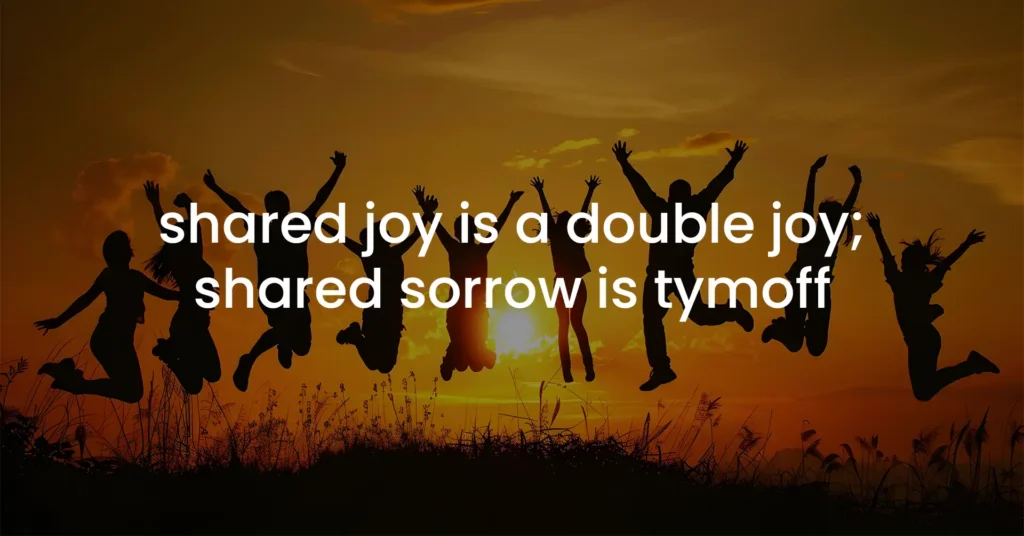In our journey through life, the experiences we share with others profoundly shape our perceptions and emotional states. Among the most universal sentiments are joy and sorrow. The phrase “shared joy is a double joy; shared sorrow is Tymoff” encapsulates the profound understanding that joy, when shared, becomes more significant and that sorrow, when shared, can serve as a bonding experience. This article delves into the intricate dynamics of shared emotions, exploring how joy multiplies in connection with others while sorrow can unite us, reinforcing the notion that our emotional experiences are inherently tied to our relationships with others.
The Nature of Shared Joy
Joy is a fundamental human experience that brings with it a sense of fulfillment, happiness, and contentment. However, the joy we experience can feel amplified when shared with others. This phenomenon is deeply rooted in our social nature as humans. When we share joyful moments—whether it’s a personal achievement, a celebration, or simply enjoying a beautiful day—the happiness we feel becomes magnified.
The Psychology Behind Shared Joy
Psychological research supports the notion that shared joy leads to greater emotional benefits. According to studies in positive psychology, sharing good news or joyful experiences can enhance our happiness levels. When we express joy, our brain releases dopamine, a neurotransmitter associated with pleasure. Sharing this joy with others not only enhances our feelings but also reinforces social bonds, fostering a sense of belonging and community.
When we celebrate milestones with friends and family—such as weddings, graduations, or birthdays—we are not merely marking the occasion but creating shared memories that deepen our connections. The joy derived from these experiences can lead to stronger relationships and a support network that enriches our lives. Furthermore, when we recount these joyful moments, we often relive the emotions associated with them, amplifying our happiness even further.
The Role of Communication in Joy Sharing
Communication plays a crucial role in how joy is shared. Verbal expressions, body language, and even non-verbal cues contribute to the amplification of joy. Sharing a laugh, a hug, or an enthusiastic shout of celebration can enhance the emotional impact of the joyful experience. For instance, when a child scores a goal in a soccer game, the cheers from parents, teammates, and friends create an environment where the child feels a heightened sense of achievement. This collective joy not only makes the moment memorable but also instills a sense of accomplishment that can motivate the child in future endeavors.
Moreover, the act of sharing joy creates a cycle of positivity. When we express joy, we inspire others to share their happiness, creating an atmosphere of celebration. This ripple effect can transform a simple moment of happiness into a communal experience that brings people together, fostering a sense of unity and belonging.
The Impact of Shared Sorrow
While joy brings people together, sorrow can also serve as a profound unifying force. The phrase “shared sorrow is Tymoff” highlights the idea that sorrow, while painful, can create deep connections and empathy among individuals. When we experience loss, grief, or hardship, sharing these experiences can foster a sense of understanding and support that is invaluable during difficult times.
Understanding the Healing Power of Shared Sorrow
Sharing sorrow has therapeutic effects. When individuals talk about their pain, they often find solace in the empathy and understanding of others. This connection helps individuals process their emotions, making it easier to cope with their grief. For example, support groups for those who have lost loved ones provide a safe space for individuals to share their stories and feelings. The shared experience of grief allows members to validate each other’s emotions, fostering a sense of community and mutual support.
In contrast to joy, which can sometimes lead to feelings of isolation when not shared, sorrow has a unique ability to bring people closer. When we share our struggles, we not only lighten our emotional load but also create an opportunity for others to relate to our experiences. This can lead to a deeper understanding of one another, breaking down barriers and fostering connections that may not have existed otherwise.
The Social Bonding of Shared Sorrow
The unifying power of shared sorrow extends beyond individual experiences. Historical events, such as natural disasters or national tragedies, often elicit widespread sorrow that brings communities together. During these times, collective mourning can foster solidarity, as individuals come together to support one another. The shared experience of grief can create a powerful sense of belonging and community, transcending individual differences.
Moreover, shared sorrow can serve as a catalyst for change. When people come together in the face of tragedy, they often channel their grief into action, whether through charitable initiatives, advocacy, or support for one another. This collective effort not only honors those who have suffered but also creates a sense of purpose that can lead to positive change in society.
The Balance Between Joy and Sorrow
Understanding the relationship between joy and sorrow is crucial for emotional resilience. Life is a complex tapestry of experiences, where joy and sorrow coexist, influencing one another in profound ways. Recognizing that both emotions are integral to the human experience allows us to embrace a more balanced perspective on life.
Finding Strength in Vulnerability
One of the most significant lessons learned from acknowledging the duality of joy and sorrow is the strength found in vulnerability. Embracing our emotions—whether they are joyous or sorrowful—can lead to deeper connections with ourselves and others. In sharing our struggles and triumphs, we allow others to see us authentically, fostering a sense of intimacy that can strengthen relationships.
When we express our joy, we invite others to celebrate with us, and when we share our sorrow, we create an opportunity for empathy and support. This interplay of emotions can foster a culture of openness, where individuals feel comfortable expressing their true selves without fear of judgment.
The Role of Empathy in Emotional Sharing
Empathy is at the heart of both shared joy and shared sorrow. It is the ability to understand and share the feelings of another, creating a bridge between individuals that enhances emotional experiences. When we celebrate together, empathy allows us to feel the joy of others deeply. Conversely, when we share sorrow, empathy enables us to provide comfort and support, reinforcing the bonds of human connection.
Empathetic responses can take various forms, from active listening to providing practical assistance. When we genuinely engage with the emotions of others, we create a safe space for sharing. This connection not only enriches our emotional experiences but also fosters a sense of belonging that is essential for mental and emotional well-being.
Creating Communities of Shared Emotions
Building communities centered around shared emotions can have a transformative impact on individual and collective well-being. Whether through friendships, family ties, or community organizations, fostering spaces where joy and sorrow can be shared openly promotes emotional health and resilience.
Celebrating Joy Together
Communities that celebrate joy together often create traditions and rituals that reinforce the significance of shared happiness. Festivals, family gatherings, and community events provide opportunities for individuals to come together, share experiences, and strengthen their connections. These gatherings not only amplify joy but also create lasting memories that individuals carry with them throughout their lives.
For instance, annual community events such as fairs or holiday celebrations foster a sense of belonging and connection. These occasions encourage individuals to engage with one another, reinforcing social ties that enhance community cohesion. In addition, shared joy during these events can lead to new friendships and strengthen existing ones, contributing to a supportive network that individuals can rely on during challenging times.
Supporting One Another in Times of Sorrow
Similarly, communities that support one another during times of sorrow can provide a lifeline for individuals facing hardship. Establishing support networks, such as grief groups or mental health initiatives, allows individuals to share their experiences and find solace in the company of others. These groups create safe spaces where individuals can express their feelings, share coping strategies, and find comfort in knowing they are not alone in their struggles.
Moreover, community support during times of sorrow can lead to collective healing. When individuals come together to honor those who have passed or support one another through grief, they create a shared narrative that reinforces community ties. This solidarity can be especially powerful in times of crisis, as individuals rally around one another, offering practical assistance and emotional support.
The Personal Journey of Emotional Sharing
While the dynamics of shared joy and sorrow often play out on a community level, the personal journey of emotional sharing is equally important. Individuals must navigate their unique emotional landscapes, learning how to express their feelings and connect with others authentically.
Embracing Authenticity in Emotion
Being authentic in emotional expression requires courage and vulnerability. Individuals may feel hesitant to share their emotions due to fear of judgment or rejection. However, embracing authenticity can lead to deeper connections and a greater understanding of oneself and others. When we allow ourselves to be vulnerable, we open the door to genuine connections, enabling others to relate to our experiences and share their own.
Creating an environment that fosters authenticity begins with self-awareness. Understanding our emotions and being honest with ourselves about what we feel is essential for effective emotional sharing. This self-awareness allows us to communicate our feelings to others, creating opportunities for connection and support.
The Journey of Emotional Growth
The journey of shared emotions is also a journey of growth. As individuals learn to navigate the complexities of joy and sorrow, they develop emotional resilience and empathy. This growth is often accompanied by a deeper understanding of oneself and others, leading to more meaningful relationships and a greater appreciation for the human experience.
By recognizing the value of shared joy and sorrow, individuals can cultivate a richer emotional life. Engaging with others, whether through celebrations or support during difficult times, enhances emotional intelligence and fosters a sense of community that can be transformative.
Conclusion: Embracing the Full Spectrum of Emotion
In conclusion, the phrase “shared joy is a double joy; shared sorrow is Tymoff” captures the essence of human connection through emotional experiences. Joy, when shared, multiplies, enriching our lives and strengthening our bonds with others. Sorrow, too, has the power to unite us, providing a space for empathy and understanding in times of difficulty.
By embracing both joy and sorrow as integral parts of the human experience, we open ourselves to deeper connections and a richer emotional life. Whether through celebrations or support during challenging times, our shared experiences shape our identities and reinforce the importance of community and connection. As we navigate the complexities of life, let us remember the profound wisdom in shared emotions, allowing them to guide us on our journey toward authenticity, resilience, and meaningful relationships. Read More Article: Self-Control is Strength. Calmness is Mastery. Embrace It – Tymoff




